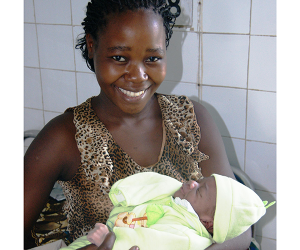Breastfeeding Basics
Breastfeeding’s impact on child survival
Breastfeeding in the first hour of life could prevent almost one million deaths every year [1] . Optimal breastfeeding of infants under two years of age has the greatest potential impact on child survival of all preventive interventions, with the potential to prevent over 800,000 deaths (13 per cent of all deaths) in children under five in the developing world (Lancet 2013) [2] .
Breastfed children have at least six times greater chance of survival in the early months than non-breastfed children. The potential impact of optimal breastfeeding practices is especially important in developing countries that have a high burden of disease and low access to clean water and sanitation. But non-breastfed children in industrialized countries are also at greater risk of dying – a recent study in the United States found a 25% increase in deaths among non-breastfed infants. In a UK survey, six months of exclusive breastfeeding was associated with a 53% decrease in hospital admissions for diarrhea and a 27% decrease in respiratory tract infections [3] .
UNICEF and WHO recommend that:
- Breastfeeding begin within one hour of birth,
- Babies receive only breast milk (not even water) for the first six months,
- Mothers actively breastfeed their babies (i.e., feed at least 10 times a day) for the first six months, and
- Breastfeeding continue with safe, nutritious foods and drinks from 6 months until the child is at least two years old.
In addition, to breastfeed optimally, mothers need to keep up their strength. They should eat two extra meals a day of diverse, nutritious foods until the child is 2 years old and they stop breastfeeding.
More information about the benefits of breastfeeding and the risks of less-than-optimum breastfeeding practices can be found in Appendix B: More Information on Breastfeeding.
These definitions will help ensure a common understanding of terms used in this I-Kit.
Active breastfeeding: Responding to the child’s hunger cues and encouraging the child to breastfeed.
Artificial feeding: Infant is fed only on a breast-milk substitute.
Baby-friendly household hospital initiative (BFHHI): Launch by WHO/UNCIEF in 1991, this initiative ensure that all birthing hospital and centers become “centers of breastfeeding support.” For more information, see https://www.babyfriendlyusa.org/about-us/baby-friendly-hospital-initiative/bfhi-worldwide.
Breast milk substitutes: Any food being represented as a partial or total replacement for breast milk.
Breastfeeding week: A week (August 1-7) every year that is celebrated worldwide as a time for promoting optimal breastfeeding practices.
Child mortality rate: For every 1000 live births, the number of children who die before age 5.
Complementary feeding: From age six months, the child receives both breast milk and appropriate solid (semi-solid or soft) foods until the child is two years old. The type, amount and consistency of food will vary based on the child’s age during this time.
Colostrum: Colostrum is the first milk from the mother, usually thick, sticky and yellowish. Colostrum should be fed to the baby after delivery. Colostrum is rich in protein and contains antibodies to protect babies from disease.
Exclusive breastfeeding: Giving only breast milk (not even water), whenever the baby wants to eat, at least 10 times each day. If needed, exclusively breastfed infants can be given ORS, medicines, vitamins and minerals.
Formative research: Research done before designing a project, strategy, or materials in order to inform the design. Formative research for developing an SBCC strategy must include qualitative research that sheds light on not only what audience members do but also why they do it. Qualitative research allows for a more in-depth understanding of people and their behaviors.
Formula: Artificial milk for babies made out of things such as sugar, animal milk, soybean, and vegetable oils. They are usually sold as a powder, to be mixed with water.
Gatekeepers: People who control or strongly influence what others can do. Gatekeeper for new mothers might include the mother’s partner/husband, parents, and parents-in-law, for example.
Immune system: Immunity is the ability to resist something harmful. The human body has natural defenses against infection and diseases. These defenses are called the human immune system.
Innocenti declaration: A declaration designed by participants of a WHO/UNICEF policy-makers’ meeting in 1990 that protects, supports and promotes breastfeeding. For more information, see: http://www.unicef.org/programme/breastfeeding/innocenti.htm.
Infant: A child under one year old.
Initial breastfeeding: The first time a baby is breastfed. Initial breastfeeding should take place within the first hour after delivery. Colostrum should be fed to the baby during this time.
International Code of Marketing of Breast-milk Substitutes: The World Health Assembly adopted this code to promote and protect breastfeeding. It states in part that there should be no promotion of breastmilk substitutes, bottles and teats to the general public; that neither health facilities nor health professionals should promote substitutes and that free samples should not be given out. Since 1981, 84 countries have enacted legislation implementing all or many of the provisions. For more information, see www.who.int/nutrition/publications/code_english.pdf.
Nutrition for breastfeeding mothers: Breastfeeding mothers should eat two extra meals per day. All of her meals should consist of nutritious foods from seven food groups [4] :
| 1. Grains, roots and tubers | 5. Eggs |
| 2. Legumes and nuts | 6. Vitamin A rich fruits and vegetables |
| 3. Dairy products (milk, yoghurt, cheese) | 7. Other fruits and vegetables |
| 4. Meat, fish, poultry, and liver/organ meats |
Mixed feeding: Infant receives both breast milk and any other food or liquid including water, non-human milk, and formula before 6 months of age.
Optimal breastfeeding practices: The baby is fed colostrum (and nothing else) in the first hour after birth, is exclusively breastfed for the first 6 months, receives complementary feeding starting at 6 months, and is breastfed at least until age 2.
Pre-lacteal feed: Giving the newborn water, tea, herbs, formula, or any substance other than colostrum after birth and before the first breastfeed.
Sub-optimal breastfeeding practices: artificial feeding, mixed feeding, pre-lacteal feed, withholding breast milk when the infant is hungry.


